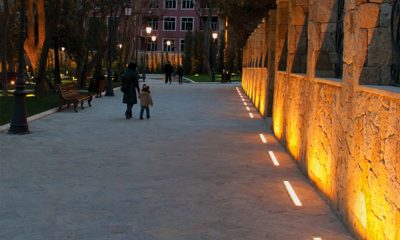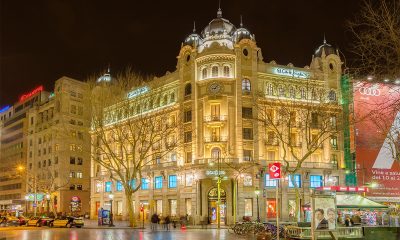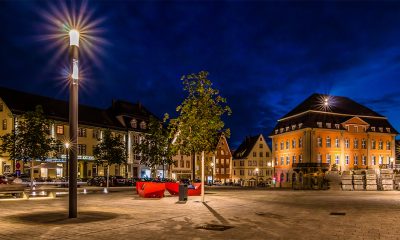What is a direct view pixel light
A direct view pixel light is an individually addressable lighting node that can respond to control signals broadcast by a network controller and produce a point of precisely controlled light. The LED node is designed as a building block for creating architectural, signage, and media facade lighting projects in installations of any size and complexity.
Direct-view pixel luminaires are digitally controllable lights in a modular design which, in conjunction with a centralized control system that coordinates all the elements in the lighting network, provide a scalable platform with a host of different customization options. The discrete LED nodes that produce points of light overcome the physical limitation of linear direct-view luminaires which create lines of light. Their small node size allows these luminaires to accommodate a variety of irregular surfaces and planes as well as two- and three-dimensional configurations.
Smart, adaptable, scalable, and extraordinary, LED pixel nodes find their indispensable use in extensive installations for architectural accent lighting, building facade lighting, structure highlighting, large-scale signage, and building-covering video displays.
How LEDs create luminous wonders
The ability of digitally controllable LED pixel nodes to bring light, color, and motion to a structure is rooted in the unique nature of semiconductor-based solid state lighting. An LED is a p-n junction device constructed of p-type and n-type semiconductor compound layers. When the p–n junction is electrically biased in the forward direction, electrons in the n-type semiconductor layers and holes in the p-type semiconductor layers recombine in the active region between the p-type and n-type semiconductors. The electron-hole recombination causes the electron to drop to a lower energy level and release energy in the form of a photon.
This injection electroluminescence effect results in narrow-band optical radiation having typical bandwidths of a few tens of nanometers. The narrow wavelength distribution of radiant energy makes LEDs monochromatic light sources that appear to emit light having a single color, e.g., red, green, and blue. The color of the emitted photons can be tuned by varying the composition of the semiconducting material used to form the junction of the LED and thickness of the quantum wells (QWs). Therefore, LEDs are intrinsically capable of producing colored light for a wide range of applications that require color effects to engage and impress audience.
Depending on the application, optional wavelength converters are used to broaden the bandwidth of the emitted light. White light in a full spectrum of shades can be created by partially or completely converting the electroluminescence using phosphor down-converters. In addition to chip- and package-level spectral engineering, the physical characteristics of LEDs allow for additive color mixing of the three primary colors of visible light (red, green, and blue) for secondary colors. LEDs are dimmable light sources. Instantaneous control of the component LEDs over a full range of intensity provides color mixer systems the ability to deliver dynamic colors.
Color options
Direct-view pixel luminaires incorporate LEDs in color options of solid white, solid color, tunable white, and dynamic color. A tunable white luminaire contains a mixture of LEDs in different color temperatures. By mixing the light emitted from these LEDs the color temperature of the light exiting the luminaire can be adjusted continuously over the defined range (typically from 2700K to 6500K). Dynamic color luminaires work in the similar way, using of a minimum of three primary colors to adjust color within the defined gamut.
RGB luminaires remain the default option for color-changing installations. While they are capable of producing intensely saturated color light that allows lighting professionals to easily match legacy implementations, they cannot produce high quality white, saturated reds, and a full range of pastels. Adding a separate white LED to an RGB LED to create an RGBW LED enables a full spectrum of saturated color and high-quality white light to be precisely targeted.
Multi-channel color mixer systems can be divided into two types: multi-die LED packages and multi-package LED arrays. An integrated multi-color packages incorporates all component LEDs into a single package. A multi-package LED array uses multiple LED packages that emit different colors to perform additive color mixing. Multi-package LED arrays are used in applications where brighter nodes are needed to create more reach and impact.
Direct-view LED luminaires project light out from the building. They’re different from other architectural lighting products in that their optical performance focuses on luminance which dictates the visual sensation (brightness) of the nodes. The higher the luminance is, the longer the reach and the more striking the visual effect direct-view pixel luminaires will deliver.
Color consistency across all luminaires of an installation is a critical detail in direct-view lighting applications. To create highly consistent products, all the LEDs incorporated in these products must be sorted by lumen output, color, and sometimes forward voltage.
Dimming technology
Direct-view pixel luminaires are generally low voltage systems that are designed to accept 12V, 24V, or 48V DC input. Each LED channel is individually driven for maximum controllability. The controllability of an LED depends on the driver’s ability to perform dimming control. There are two ways of dimming LEDs through the driver circuitry: constant current reduction (CCR), or analog dimming, and pulse-width modulation (PWM), or digital dimming.
Analog dimming regulates the brightness of an LED by directly adjusting the forward current of the LED. Digital dimming changes the brightness of an LED by adjusting the duty cycle of the waveform, i.e., the on time. Analog dimming is simple to implement because the dimming circuit simply reduces the current to dim the LEDs and does not produce electromagnetic interference (EMI). However, the light output with CCR dimming is not always linear in relation to the drive current. The color of the LED can shift with changes in forward current, and the dimming range is often limited in the range of 10% to 100%.
PWM dimming will only run the LEDs at the rated current, which allows the color to be maintained regardless of the dimming level. LED drivers with PWM dimming capability can dim the LED light output over a full range from 100% to 0. PWM operation may generate EMI from the high-frequency switching, which in turn adds design complexity and cost to the driver circuit. Nevertheless, PWM dimming is often the first choice in dynamic color lighting application. To produce predictable colors from a color mixer system, each of its component LEDs (e.g., the red, green and blue diodes of an RGB LED) requires individual, accurate, and even full range dimming control.
Control protocol
Intelligent architectural lighting and video content delivery can only be implemented when the dimmable drivers that control the individual LED channels are able to communicate and interact with a centralized control device. The drivers must be able to accept control input through an interface. While this interface can be 0-10VDC or digital addressable lighting interface (DALI), large scale or dynamic lighting installations require the use of interfaces that allow control of a large number of digital nodes.
Direct-view pixel luminaires typically run on a DMX or Ethernet network. The LED channels of an LED node in a DMX network are programmed to receive separate channels of data from a network controller. The LED node uses a controller chip that integrates all necessary circuitry for power, communications, and control to drive and ordinate independent LED channels. The controller chip combines digital LED control and communication technology in a tiny package to receive a serial command bitstream, decode and extract PWM values, perform dimming control or color mixing, and re-create a new serial bitstream. The PWM generator can support 256-to-1 (8-bit) and even 864-to-1 (12-bit) dimming ratios, which enables creation of up to 64 billion additive RGB colors.
The microcontroller has an addressing mechanism which eliminates the need to manually address individual nodes. Addressing enables LED nodes in the lighting network to extract the correct segment of data from the data stream sent out by a DMX or Ethernet controller. Using the data targeted for its channel addresses, a pixel luminaire can display the correct light output.
DMX/Ethernet lighting controller
A DMX- or Ethernet-based LED lighting controller communicates with LED pixel luminaires using DMX addresses. Uniquely addressing and controlling multiple lighting nodes allows them to display different light output or different colors and different luminances simultaneously. A single-universe DMX controller can manage a maximum of 170 uniquely addressed three-channel LED nodes. Because of wiring infrastructure and addressing limitations, DMX control is used to manage relatively simple installations, or for light shows in which multiple pixel luminaires operate in unison. Furthermore, DMX is a unidirectional communication protocol. The Remote Device Management (RDM) standard is an enhancement to the DMX protocol. It allows for bidirectional communication between the lighting nodes and controller.
Light shows with expansive and intricate dynamic effects, and large-scale video displays require tens of thousands of individually controllable points of color-changing LED nodes and thus consume a large number of DMX addresses. Ethernet control solutions, which are based on protocols such as KiNET, ArtNET and sACN, overcome the physical limitations of DMX. They allow simultaneous transmission of multiple DMX universes over a single Ethernet cable. This level of control brings all the drama and excitement of stage lighting to architectural lighting and enables translation of video content for display on media facades. Ethernet offers bidirectional communications to enable automated discovery, configuration, and addressing of the network nodes.
DMX- and Ethernet-based LED lighting controllers have software components for mapping all LED nodes, assigning effects to these nodes, grouping nodes to simplify playback control, and simulating light shows online or on the lighting network itself.
Infinite possibilities
Direct-view LED pixel nodes are designed as flexible strands of watertight luminaires that allow for installation on a virtually limitless array of surfaces and structures. A rugged construction and a minimum ingress protection rating of IP66 ensure reliability and durability in even the harshest environments. In addition to a diversity of color and luminance options, this type of products is offered with variable pixel pitches, lens options, beam angles, and form factors for flexible designs. These versatile luminaires can be deployed in grids or long runs in any form to create illuminated signs, channel letters, media façades, mesh screens, video displays, or intriguing architectural or structural lighting solutions for sports arenas, skyscrapers, bridges, landmarks, Ferris wheels, etc.


















Loading...